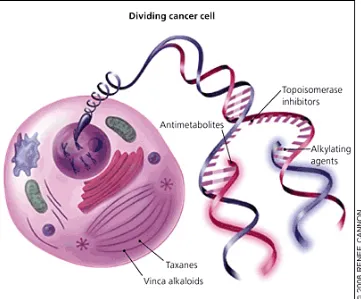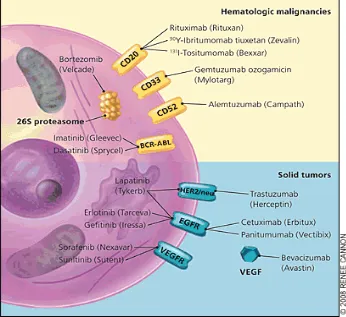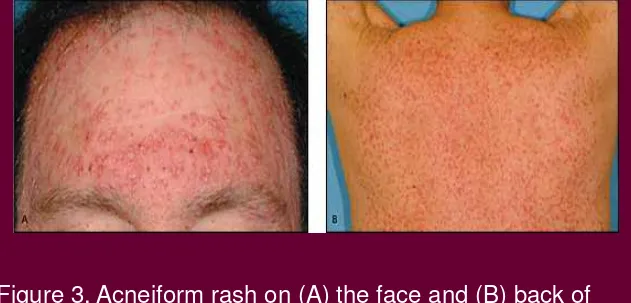! "#$#
% "
"%$ &
#"
Introduction
• Surgery , radiation and chemotherapy have led to increase survival rates for certain types of cancer.
However, there are some types of cancer e.g. lung and G.I.T (liver cancer) cancers often do not respond well to such type of treatment ,in addition to the marked side effects that have been observed.Therefore additional cancer therapy is strongly recommended.The latter cancer therapy is strongly recommended.The latter
should be targeting therapy based on biochemical and biological approach.
• Novel promissing biological –biochemical therapy for cancer
• 1-Bio-immunotherapy.
• 2-Anti-angiogenesis & anti-metastasis inducer biomolecules.
• 3-Apoptosis inducer therapy.
Chemotherapy
Shortcomings:A. Nature of cytotoxin
B. Lack of in vivo selectivity
C. The mechanism of anti-proliferation on cells cycle, rather than specific toxicity directed towards particular cancer cell
D. Host toxixity: treatment discontinued, most of them had bad side-effects, such as no appetites, omit, lose hair
Side Effects of Chemotherapy
Immediate Early Delayed Late
(hours - days) (days - weeks) (weeks- months) (months - yrs) Extravasation Myelosuppression Cardiotoxicity Second Cancer Emesis Mucositis Lung fibrosis Encephalopathy Hypersensitivity Alopecia P. Neuropathy Sterility
Changing of the Guard
•
There is a paradigm shift in the
treatment of cancer
•
Conventional cytotoxic drugs interact
•
Conventional cytotoxic drugs interact
with DNA to prevent cell replication but
are not specific to cancer cells
•
We are moving to targeted therapies
The Paradigm Shift
•
The use of these drugs is giving
clinicians a glimmer of the paradigm
shift that will occur in the treatment of
cancer
cancer
•
One or several new targeted therapies
Targeted Therapy: A definition
• Drugs targeted at pathways, processes and physiology which are uniquely disrupted in cancer cells:
– Receptors – Genes
– Angiogenesis – Tumor pH
Targeted therapies
• With targeted therapy the specific
mechanism of action of the drug results in an increase in its therapeutic index
• However, the advantages of the specificity
• However, the advantages of the specificity
and safety of the are offset by the smaller number of susceptible tumour types
• Increasing numbers of these innovative and
The Need to Identify the Target
• Appropriate use of newly approved and
expensive targeted therapies for cancer first
depends on the pathologist identifying the target for treatment in the tumour sample
• Currently the two major classes of targeted • Currently the two major classes of targeted
therapy are:
= the small molecule tyrosine kinase inhibitors (TKIs) and
Six Essential Alterations
in Cell Physiology in Malignancy
Insensitivity to anti-growth signals
Self-sufficiency in growth signals
Evading apoptosis
Targets for classical drugs?
Hanahan & Weinberg, Cell 100:57 (2000)
Limitless replicative potential
Tissue invasion & metastasis Sustained
angiogenesis
Figure 1. Mechanisms of traditional chemotherapy. These drugs act on rapidly dividing cells, which include normal tissues (e.g., hair, gastrointestinal epithelium, bone marrow) in addition to cancer cells. Alkylating agents interfere with DNA base pairing, leading to strand breaks and arresting DNA replication. Topoisomerase inhibitors prevent DNA uncoiling. Taxanes and vinca alkaloids interfere with
Figure 2. Mechanisms of targeted therapies. The molecular targets in this figure are not overexpressed in a single cell type, but rather on various malignant and normal tissues. For example, CD20 is present on lymphoma and normal lymphoid cells, HER2/neu is present on 25 percent of breast cancer cells, and VEGFR is present on normal and
tumor-associated vasculature. Downstream intracellular signaling molecules, some of which are targeted by small molecule inhibitors, are not depicted. Some drugs (e.g., sorafenib
Table 1. Glossary of Oncology Terms :
Angiogenesis. The growth of new blood vessels from preexisting vasculature
Epidermal growth factor receptor (EGFR, also known as HER1).
A tyrosine kinase that, when activated by binding of specific ligands, triggers intracellular signaling that ultimately leads to cell proliferation, invasion, and migration; it is a target of treatment (with the monoclonal antibodies cetuximab [Erbitux] and panitumumab [Vectibix], and the small molecule inhibitors erlotinib [Tarceva],
gefitinib [Iressa], and lapatinib [Tykerb]) in multiple tumor types gefitinib [Iressa], and lapatinib [Tykerb]) in multiple tumor types
Fragment antigen binding (Fab). The region of an antibody responsible for recognizing and binding to antigens
HER2/neu. A tyrosine kinase related to epidermal growth factor receptor; it has a role in the pathogenesis of
breast cancer and is a target of treatment (with the monoclonal antibody trastuzumab [Herceptin] and the small molecule inhibitor lapatinib [Tykerb]) in the 25 percent of persons with breast cancer in which
HER2/neu is overexpressed. Overexpression of HER2/neu is overexpressed. Overexpression of
HER2/neu is associated with disease recurrence and worse prognosis. HER2 is named because it has
Ligand. A molecule that binds to a specific receptor.
Monoclonal antibodies. Identical antibodies produced by a single type of immune cell; in targeted cancer therapy, they are directed against molecules unique to,
overexpressed in, or mutated in cancer cells.
Small molecule inhibitors. Drugs that interfere with the function of molecules involved in the development and progression of cancer; most commonly, they interfere
with tyrosine kinases.
Tyrosine kinase. Enzyme that transfers a phosphate
group from adenosine triphosphate to a tyrosine amino acid residue in a protein, which may then trigger
downstream molecular signaling.
Vascular endothelial growth factor (VEGF). A signaling protein involved in angiogenesis; it binds to tyrosine
What is antibodies
An antibody is a protein used by the immune system to identify and neutralize foreign objects like bacteria and viruses. Each antibody recognizes a specific antigen
unique to its target.
Monoclonal antibodies (mAb) are antibodies that are identical because they were produced by one type of immune cell, all clones of a single parent cell.
Polyclonal antibodies are antibodies that are derived from different cell lines.
Isotypes Isotypes
According to differences in their heavy chain constant domains, immunoglobulins are grouped into five classes, or isotypes: IgG, IgA, IgM, IgD, and IgE.
IgG: IgG1 (66%), IgG2 (23%), IgG3 (7%) and IgG4 (4%) , blood and tissue liquid. IgA:IgA1 (90%) and IgA2 (10%), stomach and intestines
IgM: normally pentamer, ocassionally hexamer, multiple immunoglobins linked with disulfide bonds
IgD:1% of proteins in the plasma membranes of B-lymphocytes, function unknown IgE: on the surface of plasma membrane of mast cells, play a role in immediate
Monoclonal Antibodies
• Action of the mAbs, rituximab
(Mabthera®) for NHL and
trastuzumab (Herceptin®) for
breast cancer depend on the
breast cancer depend on the
targets CD20 expression and
erbB2
gene being amplified and
The structure of antibodies
The types of mAb designed
A. Murin source mAbs: rodent mAbs with
excellent affinities and specificities, generated using conventional hydrioma technology.
Clinical efficacy compromised by HAMA(human anti murine antibody) response, which lead to allergic or immune complex herpersensitivities. B. Chimeric mAbs: chimers combine the human
constant regions with the intact rodent variable regions. Affinity and specificity unchanged.
Also cause human antichimeric antibody response (30% murine resource)
Monoclonal antibodies for cancer
treatment
Mechanisms that could be responsible for the
cancer treatment.
A. mAbs act directely when binding to a cancer specific antigens and induce immunological
response to cancer cells. Such as inducing cancer cell apoptosis, inhibiting growth, or interfering with a key function.
B. mAbs was modified for delivery of a toxin,
radioisotope, cytokine or other active conjugates.
mAbs treatment for cancer cells
ADEPT, antibody directed enzyme prodrug therapy; ADCC, antibody dependent cell-mediated cytotoxicity; CDC, complement dependent
cytotoxicity; MAb, monoclonal antibody; scFv, single-chain Fv fragment.
Carter P: Improving the efficacy of antibody-based cancer therapies. Nat Rev Cancer
Mabthera
• Mabthera is an Anti-CD20 monoclonal
antibody for lymphoma
• CD20 is a protein on the surface of malignant
lymphoma cells
• CD20 expressed on 90% of B-cells in
lymphoma lymphoma
Side effects include:
Infusion related fever, chills rigors
N + V, urticaria, pruritis, headache, fatigue, bronchospasm, hypersensitivity
Rare heart rhythm disturbance
HER2
= HER2 gene (neu, c-erb-2) ecodes a transmembrane gycoprotein receptor
= HER 2 is over expressed by 1/4 human breast cancer and correlates with poorer outcome
= MoAb against the receptor inhibits the growth of = MoAb against the receptor inhibits the growth of
overexpressing cells
As a single agent 15% chance of shrinking metastatic breast cancer, 4% chance of a complete shrinkage in heavily pretreated patients
Duration of response can be 9 months which is at least as good as single chemotherapy agents
Tyrosine Kinase Inhibitors
Tyrosine Kinase Inhibitors
The Angiogenic Switch
is Necessary for Tumor Growth and Metastasis
Tumor is dormant
Neovascularization: Angiogenic switch Somatic mutation Small avascular tumor
Tumor secretion of angiogenic factors
stimulates angiogenesis
Rapid tumor growth and metastasis
Carmeliet and Jain. Nature. 2000; 407:249; Bergers and Benjamin. Nat Rev Cancer. 2003; 3:401.
• Allows rapid tumor growth by providing oxygen, nutrients, and waste removal
On The Angiogenic Switch
The Angiogenic Switch:
The Balance Hypothesis
Hanahan and Folkman. Cell. 1996; 86:353.
= Activators (eg, VEGF, bFGF, IL-8)
= Inhibitors (eg, thrombospondin-1, angiostatin, interferon αααα/ββββ)
Off
Agents targeting the
VEGF pathway
Epidermal Growth Factor Receptor
Epidermal Growth Factor Receptor
(EGFR)
(EGFR)
•• EGFR has an essential role in tumor
EGFR has an essential role in tumor
progression
progression
•• Tyrosine Kinase inhibitors block
Tyrosine Kinase inhibitors block
intracellular phosphorylation of EGFR
intracellular phosphorylation of EGFR
intracellular phosphorylation of EGFR
intracellular phosphorylation of EGFR
•• Epidermal Growth Factor Receptor
Epidermal Growth Factor Receptor
signaling impaired
signaling impaired
Gefitinib
Gefitinib
•• Small Molecule Tyrosine Kinase inhibitorSmall Molecule Tyrosine Kinase inhibitor
•• Iressa Survival Evaluation in advanced lung Iressa Survival Evaluation in advanced lung cancer
cancer
•• Gefitinib vs. placeboGefitinib vs. placebo
•• Conditional approval in 2003 on the basis of Conditional approval in 2003 on the basis of 10% response rate in clinical study
10% response rate in clinical study
•• Use restricted to responders after ISEL study Use restricted to responders after ISEL study showed no survival advantage
Erlotinib
Erlotinib
•• NCI CTC BR.21NCI CTC BR.21
•• 731 Patients731 Patients
•• NSCLCA with disease progression after NSCLCA with disease progression after chemotherapy
chemotherapy
•• Erlotinib 150mg./day PO vs. PlaceboErlotinib 150mg./day PO vs. Placebo
•• Erlotinib 150mg./day PO vs. PlaceboErlotinib 150mg./day PO vs. Placebo
•• Median survival 6.7 vs. 4.7 months (p<.001)Median survival 6.7 vs. 4.7 months (p<.001)
•• One year survival 29.7% vs. 20.5%One year survival 29.7% vs. 20.5%
•• Quality of life improvementQuality of life improvement
••FDA indication for locally advancedFDA indication for locally advanced
•• or metastatic NSCLC after failure of one or metastatic NSCLC after failure of one
STI 571 (Glivec)
• Specific inhibitor for BCR-ABL, PDGF receptor and c-kit tyrosine kinases produced by these genes which are responsible for growth in CML and GIST
• Effective in chronic myeloid leukaemia
• Effective in GIST Gastrointestinal stroma tumours which over express c-kit
• Side effects
PET Before and after Glivec
for GIST
7/12/00
Table 3. Small Molecule Inhibitors for Cancer Treatment Drug Target FDA-approved indications Toxicities, side effects, and precautions Monitoring Bortezom ib (Velcade) 26S proteaso me Multiple myeloma, mantle cell lymphoma (a subtype of non-Hodgkin's Peripheral neuropathy; myelosuppression; rash; constipation; diarrhea; edema; nausea and Signs and symptoms of peripheral neuropathy; CBC non-Hodgkin's lymphoma) nausea and vomiting Dasatinib (Sprycel) BCR-ABL, SRC family, c-KIT, PDGFR Chronic myeloid leukemia, acute lymphocytic leukemia Rash; diarrhea; pleural effusion; fluid retention; mucositis; myelosuppression; QT interval prolongation
CBC; ECG; liver chemistries;
Erlotinib (Tarceva)
EGFR Non-small cell lung cancer, pancreatic cancer
Acneiform rash; diarrhea; loss of
appetite; nausea and vomiting; fatigue; conjunctivitis; elevated liver chemistries Liver chemistries; signs of inflammatory or infectious sequelae in patients with dermatologic toxicity
Gefitinib (Iressa)
EGFR Non-small cell lung cancer
Sorafenib (Nexavar) BRAF, VEGFR, EGFR, PDGFR Renal cell cancer, hepatocellular carcinoma Hypertension; alopecia; bleeding; rash; palmar-plantar erythrodysesthesia (hand-foot syndrome); hypophosphatemia ; diarrhea; nausea and vomiting; elevated amylase Blood pressure; dermatologic toxicity (including palmar-plantar erythrodyses thesia [hand-foot syndrome]); elevated amylase
note:= All small molecule inhibitors are administered
orally except bortezomib, which is administered
intravenously
.
= Most small molecule inhibitors undergo
metabolism by cytochrome P450 enzymes and are therefore subject to multiple potential interactions e.g.: therefore subject to multiple potential interactions e.g.:
,
=anticonvulsants, azole antifungals, dexamethasone, isoniazid [Nydrazid], macrolide antibiotics, nefazodone [Serzone, brand no longer available in the United States], protease inhibitors, rifampin [Rifadin], St.
John's wort, verapamil [Calan], and warfarin
Molecularly targeted therapy for hepatocellular carcinoma
Molecular targets in the (a) epidermal growth factor (EGF) and EGF receptor (EGFR) family, (b) vascular endothelial growth factor (VEGF)
and VEGF receptor (VEGFR) family, and (c) insulin-like growth factor (IGF) and IGF receptor (IGFR). Targeted agents are
Molecularly targeted therapy for hepatocellular carcinoma
Molecular targets in mitogen-activated protein kinase (MAPK) and phosphatidylinositol-3 kinase (PI3K) signal transduction pathways
stimulated by receptor tyrosine kinases (RTK). Targeted agents are indicated by arrows. GF, growth factor; SOS, sun of sevenless; MEK, MAPK/
extracellular regulated kinase kinase; PTEN, phospharase and tensin homologue; PDK, phosphoinositide-dependent kinase; IKK, IκB kinase; mTOR,
Sorafenib in the treatment of advanced hepatocellular carcinoma
• Hepatocellular carcinoma (HCC) is the
most common primary liver tumor
responsible for about 90% of liver cancers
• Management of advanced HCC remains a
• Management of advanced HCC remains a
challenge to physicians.
• Many chemotherapeutic agents have been
tried, but none had shown a significant
Sorafenib in the treatment of advanced hepatocellular carcinoma
• Sorafenib® is a multikinase inhibitor that has
recently obtained Food and Drug Administration (FDA) approval for the treatment of advanced renal cell carcinoma (RCC).
• It has been tried in several solid tumors, including HCC.
• A recent phase III trial has shown that sorafenib significantly extends survival for patients with
Sorafenib
• Sorafenib is an inhibitor of several kinases involved in both tumor cell proliferation (tumor growth) and
angiogenesis (tumor blood supply). These include Raf, VEGFR and PDGFR.
• Raf is serine/theonine kinase, which when activated by Ras (membrane localized protein) stimulates gene
Ras (membrane localized protein) stimulates gene
transcription in the nucleus, leading to a variety of tumor-promoting cellular effects.
• VEGF is the primary mediator of both normal and tumor-associated angiogenesis. It exerts this effect through
Sorafenib
• VEGF interacts with receptors (VEGFR 1, 2, 3)
present on the endothelial cell surface, which leads to autophosphorylation of intracellular receptor tyrosine kinase, and a cascade of downstream proteins is activated.
PDGF has its receptor on the surface of capillary endothelial cells. The binding of PDGF to the
Conclusions
•
Targeted therapies which improve
the therapeutic index are the future
of anti-cancer therapy
•
Advances in molecular pathology will
•
Advances in molecular pathology will
provide the means to identify the
targets and will be used to subtype
tumours and will provide predict


